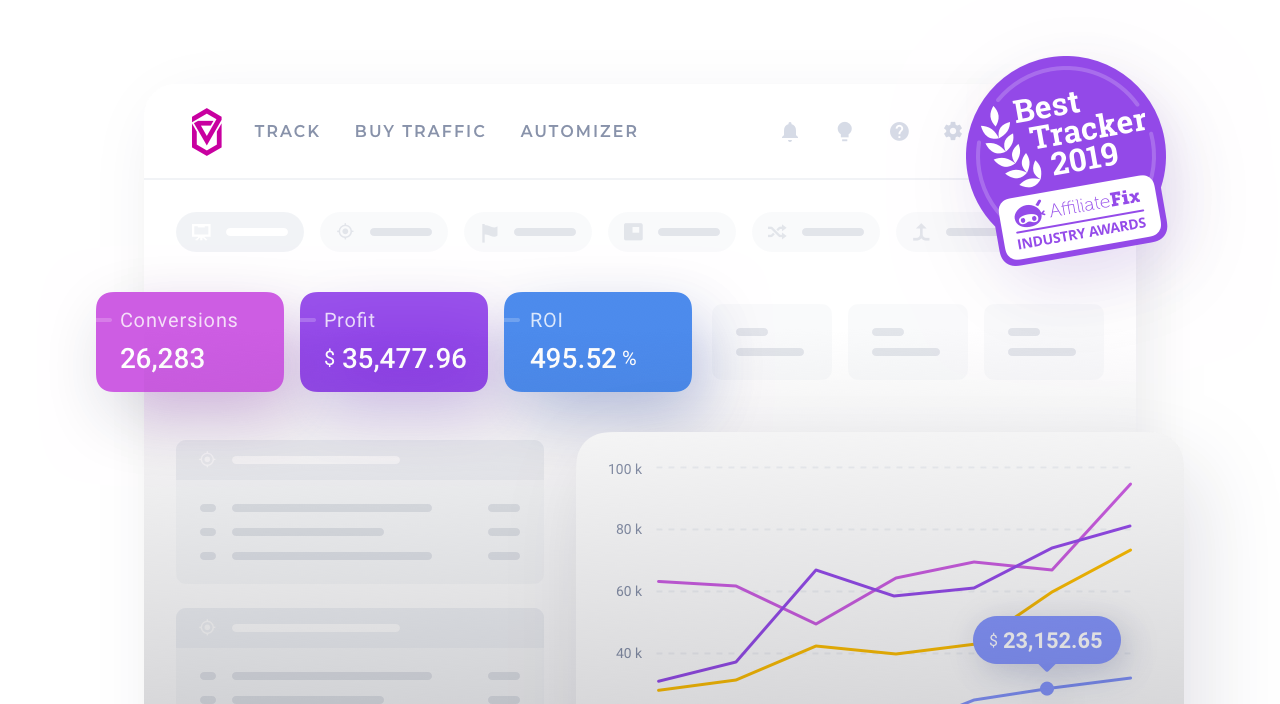TrafficFactory
TrafficFactory allows you to advertise your offers in a banner, pop-under, and contextual formats. They operate in all GEOs. The following guide instructs you on how to configure tracking of TrafficFactory campaigns with Voluum.
Before You Start
There are several things that you require before you can set up tracking with Voluum and TrafficFactory:
- An active TrafficFactory account
- An active Voluum account
- An offer
- Optionally, a landing page
- Optionally, an SSL certificate enabled on your tracking domain
Once you have everything, proceed to the remaining part of this guide.
Back to top
I. Create a Campaign in Voluum
First, you need to create a campaign funnel in Voluum, which will provide you with a campaign URL that you will submit to TrafficFactory later.
- Create an offer element. Read the Add an Offer to Voluum article to learn how to do that.
- (Optionally) Create a lander element. Read the Add a Lander Element article to learn more.
-
Create a traffic source element. Voluum provides you with the TrafficFactory traffic source template, so you can use it and skip most of the manual setup. In order to use this template, perform the following steps:
- In Voluum, go to Traffic sources.
-
Click the Create button and select the Traffic source option from the drop-down menu.

- In the New traffic source - templates form, select the TrafficFactory template from the Other templates section.
-
Click the Next button. The New traffic source form will appear.

-
You can change or adjust any option in the New traffic source form. Once you have done so, click the Save button.

-
Create a campaign.
In Voluum, go to Campaigns, click the Create button and select the Campaign Simple or Campaign Advanced option from the drop-down menu.

- In the new campaign form, select the Private Workspace that you want this campaign to be assigned to from the Workspace drop-down menu.
- Select the TrafficFactory traffic source that you have just created from the Traffic source drop-down menu.
- Provide a name for the campaign in the Campaign name text field.
- Define the cost model that you will use.
- (Optionally) Select a lander you have previously created from the Landers drop-down menu.
- Select an offer that you have just created from the Offers drop-down menu.
-
Click the Save button.

-
Click the Copy button next to the campaign URL to copy it to the clipboard and paste it to any text editing tool.

- Click the Done button.
Back to top
II. Create a Campaign in TrafficFactory
The second thing you need to do is to create an ad, a target, and a campaign in TrafficFactory. In order to do so, perform the following steps:
-
Create an ad.
-
Create a campaign and a target.
- In TrafficFactory, click the Campaigns menu.
-
Select the Add a new campaign option from the drop-down menu.

- Select the campaign type from the drop-down menu.
- Provide a name for the campaign.
- Set the bidding type.
- Paste the campaign URL that you have copied from Voluum in the URL text field.
-
Click the Save button.

- Click the Add a target button.
- Provide a name for the target.
- Set your targeting options.
- Provide value for your bid.
-
Click the Save button.

-
Click the Link banners button.

- Select the ad that you have just created and link it with the campaign.
Back to top
TrafficFactory Tracking Tokens
Token | Description |
{actual_cost} | The actual CPM / CPC paid for each impression / click. |
{campaign_id} | The ID of the campaign. |
{conversions_tracking} | The unique ID generated when customer clicks on the ad. |
{category_id} | The ID of the category detected. |
{cost} | The cost of the click or impression. |
{country} | The 3-character country code of the visitor. |
{currency} | The currency of the advertiser's account. |
{format} | The banner size. Example: 300×250. |
{keyword} | The keyword that was matched in case of campaigns targeting specific keywords. This will be empty if there is no match. |
{language} | The language of the visitor. |
{pricing_model} | The pricing model of the campaign (1 = CPC, 2 = CPM, 3 = CPA, 4 = Smart CPM, 5=CPV, 6=Dynamic CPA, 7=Smart CPC). Some networks will not use all of these. |
{referer} | Address of the web page from which the resource has been requested. |
{rtb_timeout} | The RTB Timeout value in ms (applied only on RTB calls). |
{site_id} | The ID number of the site where the ad is displayed. |
{src_hostname} | The site name that the Publisher submitted for displaying ads, not including the HTTP protocol at the beginning (e.g. examplesite.com). |
{sub} | The Publisher's Sub ID. |
{tags} | The list of keywords that have been identified for that ad impression. |
{time} | The timestamp, which is used as a cache buster. |
{url} | The full URL of the site that the Publisher submitted to the Admin Panel for displaying ads, including the HTTP protocol (e.g. https://examplesite.com). Note: This token will not display the URL where the ad was displayed to the user; only the URL that is registered in our platform. |
{user_agent} | The User Agent string of the visitor. |
{variation_id} | The ID of the variation (Banner or landing page). |
{zone_id} | The ID of the ad zone where the ad is displayed. |
{gdpr} | This will be 0 if the user is not under GDPR, and 1 if the user is under GDPR (only available on RTB). |
{gdpr_consent} | This is the GDPR consent string required by the IAB standards (only available on RTB). |
{ex_[key]} | If Custom Targeting is available, all Custom Targeting tokens will be displayed using this syntax. |
Back to top





